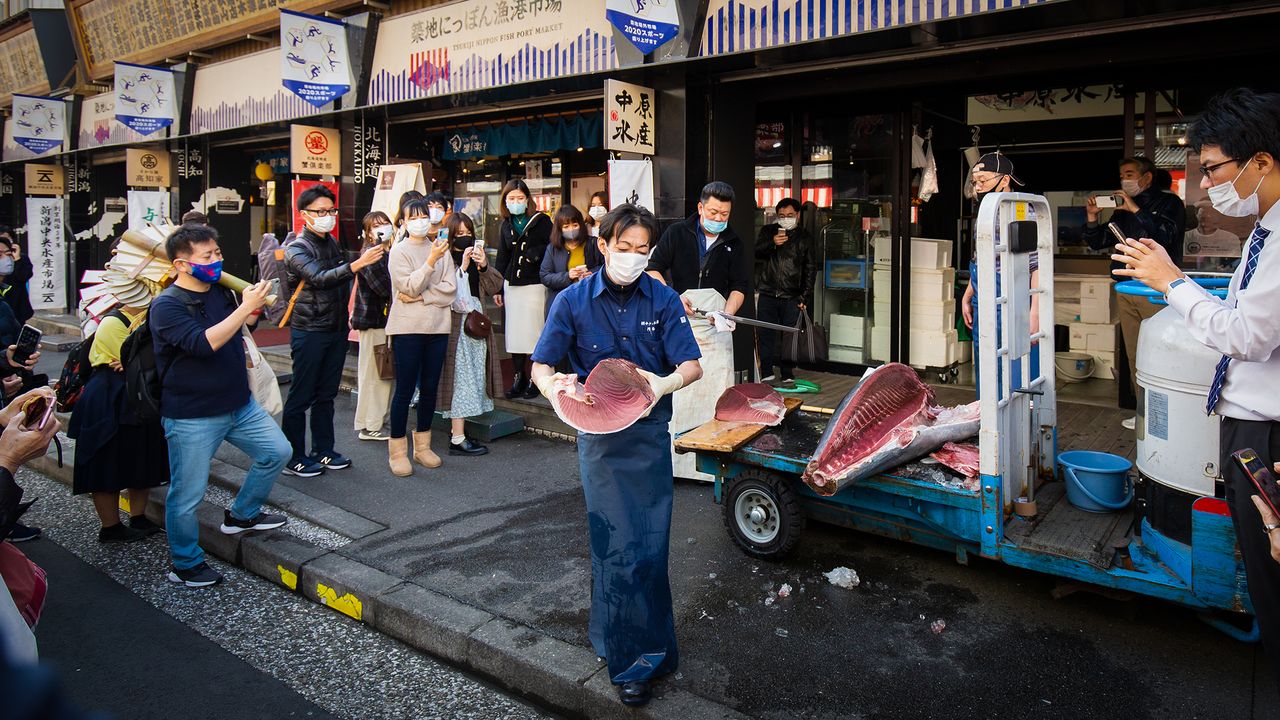
Tokyo’s Tsukiji Outer Market Comes Back to Life
Guideto Japan
Food and Drink Travel- English
- 日本語
- 简体字
- 繁體字
- Français
- Español
- العربية
- Русский
Originally adjacent to the old Tsukiji Wholesale Market, the Tsukiji Outer Market prospered as the open, public counterpoint to the wholesale market meant only for professionals. In October 2018, however, the wholesale market moved to Toyosu in Kōtō, Tokyo, bringing to a close its long 83-year history in Chūō’s Tsukiji district. People feared that this would be a major blow to the Tsukiji Outer Market vendors, but the Outer Market’s numerous fresh seafood shops, tamagoyaki (a Japanese-style omelet) shops supplying many of the sushi shops in Tokyo, and even a shop specializing in professional-quality knives are thriving, keeping intact Tsukiji’s reputation as Japan’s “kitchen.”
Close to Tokyo’s bustling Ginza and Shinbashi districts, the Tsukiji Outer Market comprises around 450 shops tightly packed in an area just southwest of the intersection of Shin Ōhashi and Harumi avenues. It is referred to as a “market” but more closely resembles a teeming shopping arcade and is completely independent of the famous wholesale market, now in Toyosu, managed by the Tokyo metropolitan government and restricted to professional buyers. The Tsukiji Outer Market has no such restriction. While the area no longer bustles with early-morning activity in the way that it used to when the wholesale market was located in Tsukiji, the public outer market still draws both professional buyers and regular customers who come to eat and shop.
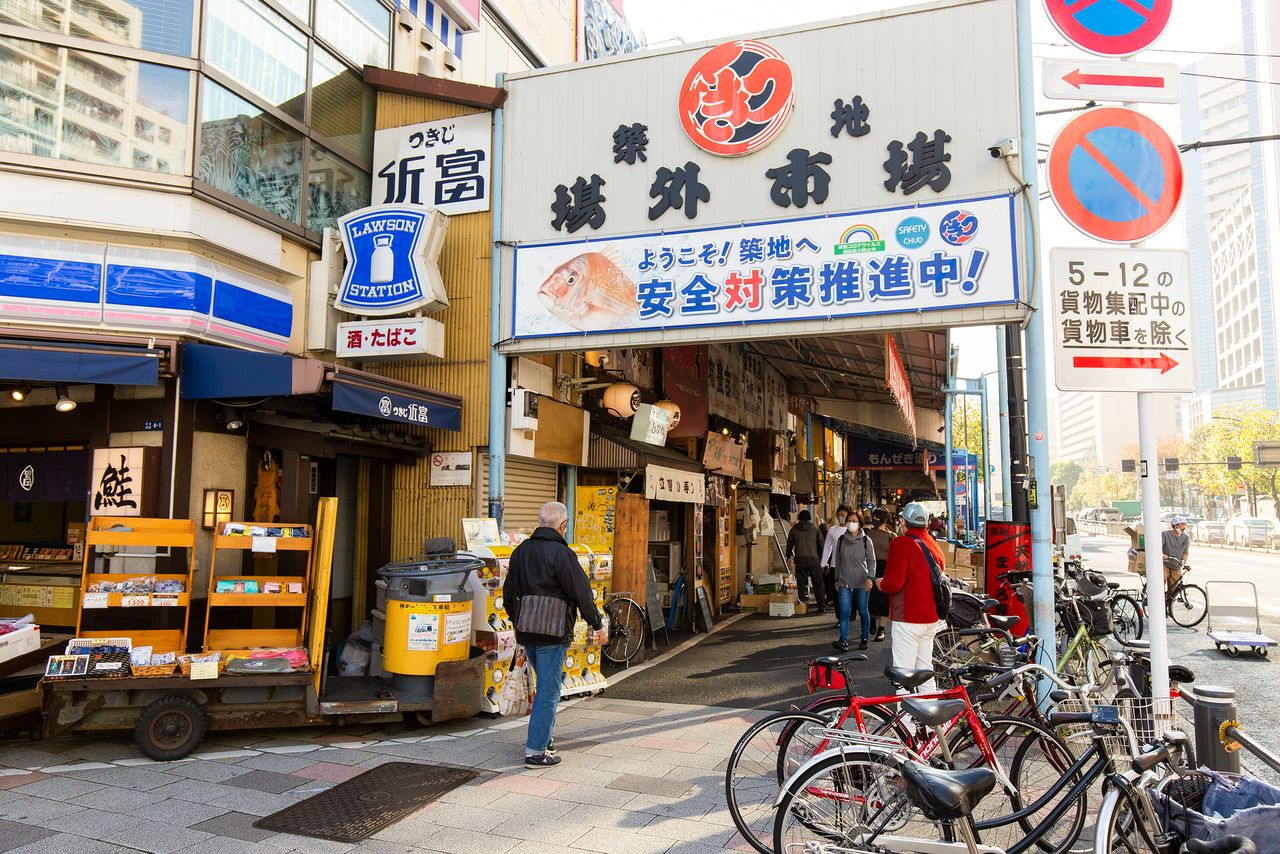
The Tsukiji 4-chōme intersection of Shin Ōhashi and Harumi avenues. From here shoppers enter Monzeki-dōri, a long line of shops bordering the western edge of Shin Ōhashi avenue.
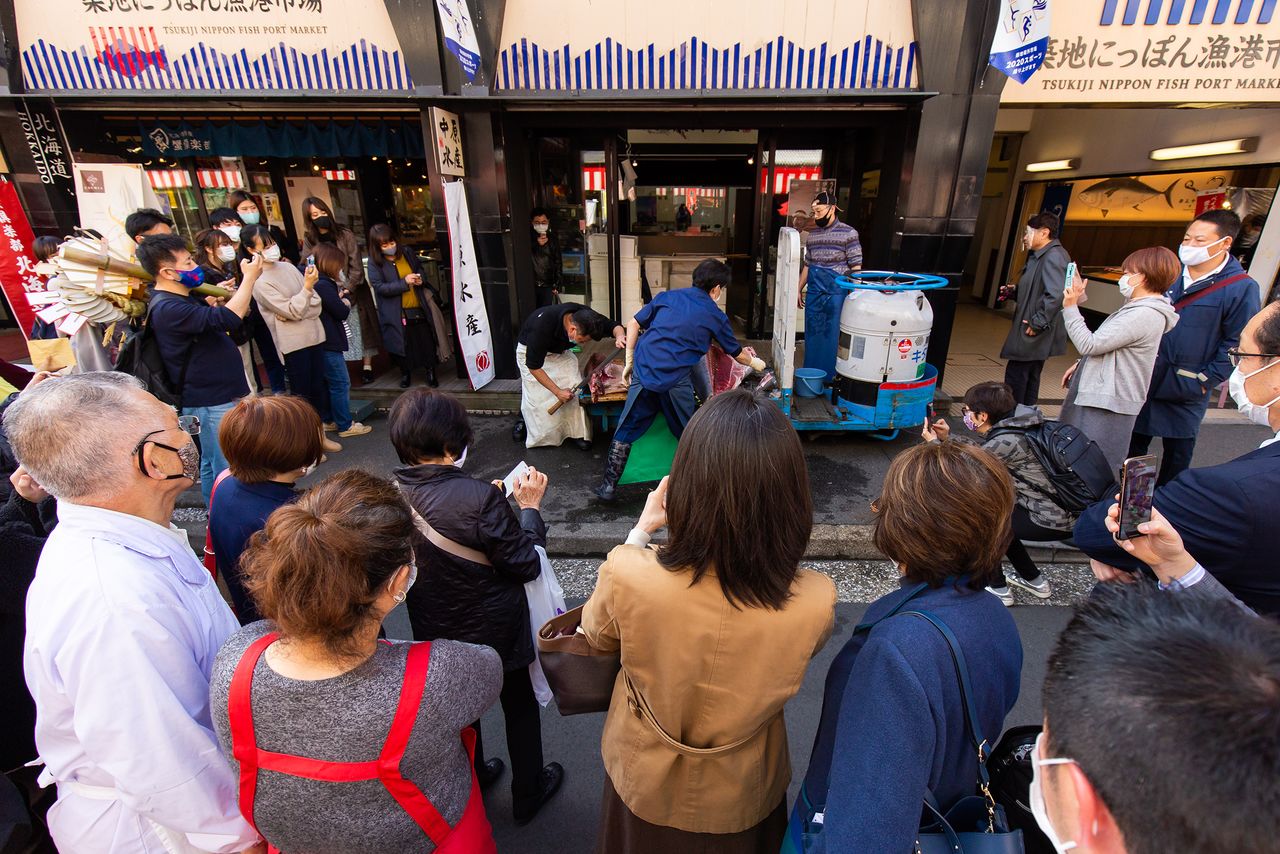
Namiyoke-dōri, running from Namiyoke Shrine to Shin Ōhashi avenue, marks the southern edge of the outer market area. If you are lucky you may be able to see a tuna carving demonstration.
High-Quality Fresh Foods to Rival Toyosu
The Tsukiji Uogashi complex is one of the major attractions of the Tsukiji Outer Market. A fresh foods wholesale complex developed by Chūō Ward to preserve the Tsukiji market tradition, Tsukiji Uogashi has around 60 retail shops operated by vendors belonging to the Toyosu Central Wholesale Market. The complex consists of two connected buildings, the Odawarabashi Building on Harumi avenue and the Kaikōbashi Building on Namiyoke-dōri. The retail shops selling fresh seafood, produce, and meat are located on the first floors of the two buildings.
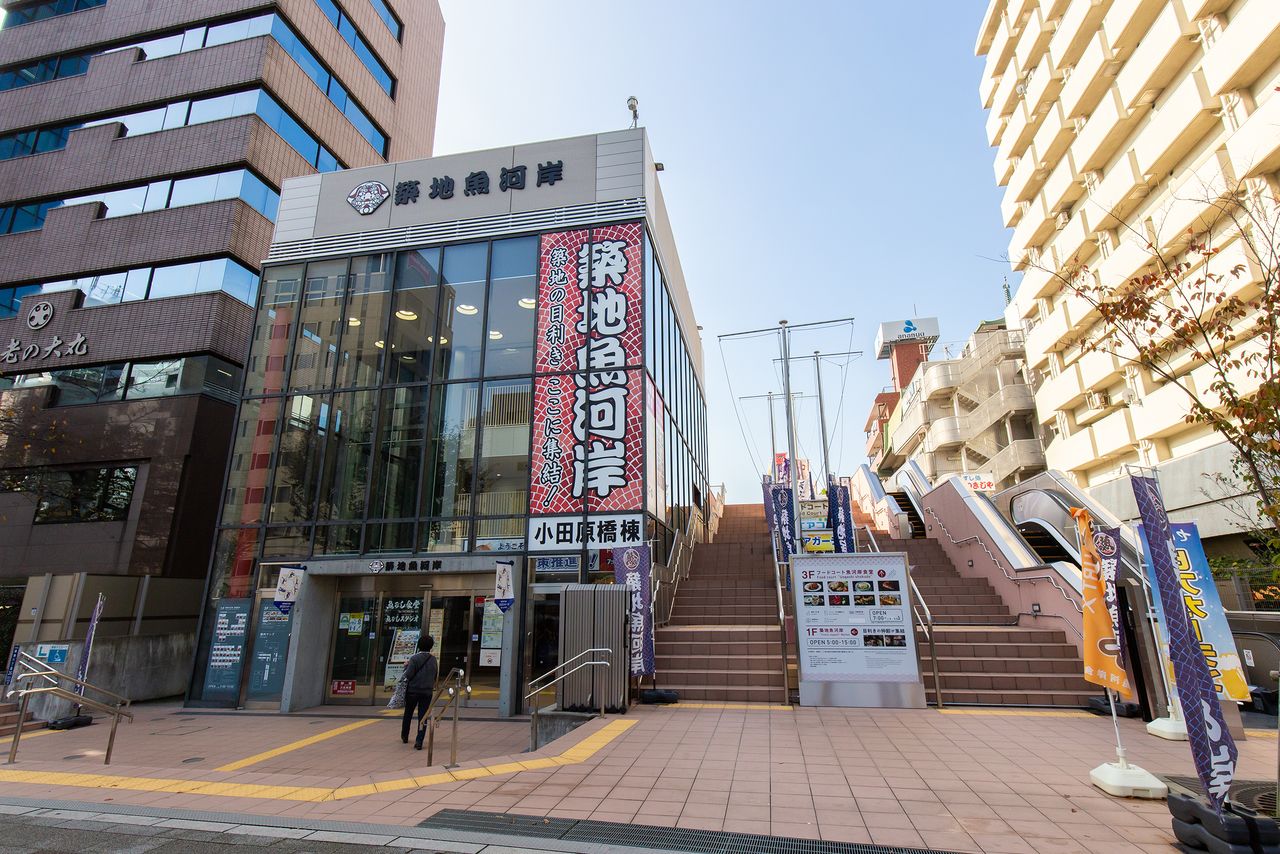
The Odawarabashi Building on Harumi venue. The stairs on the right will take you directly to the Uogashi Shokudō food court on the third floor.
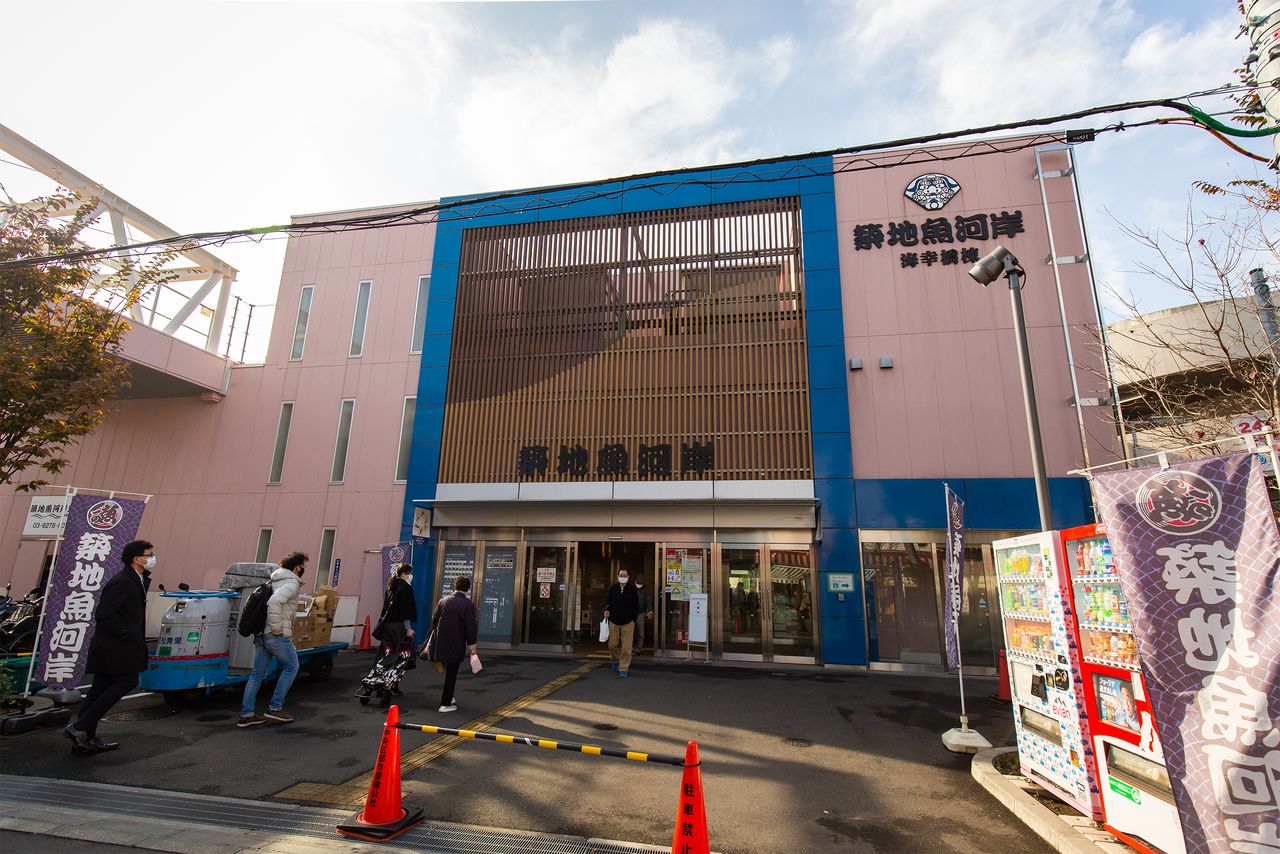
Main entrance to the Kaikōbashi Building in front of Namiyoke Shrine. The building is connected by a third-floor passageway to the Odawarabashi Building.
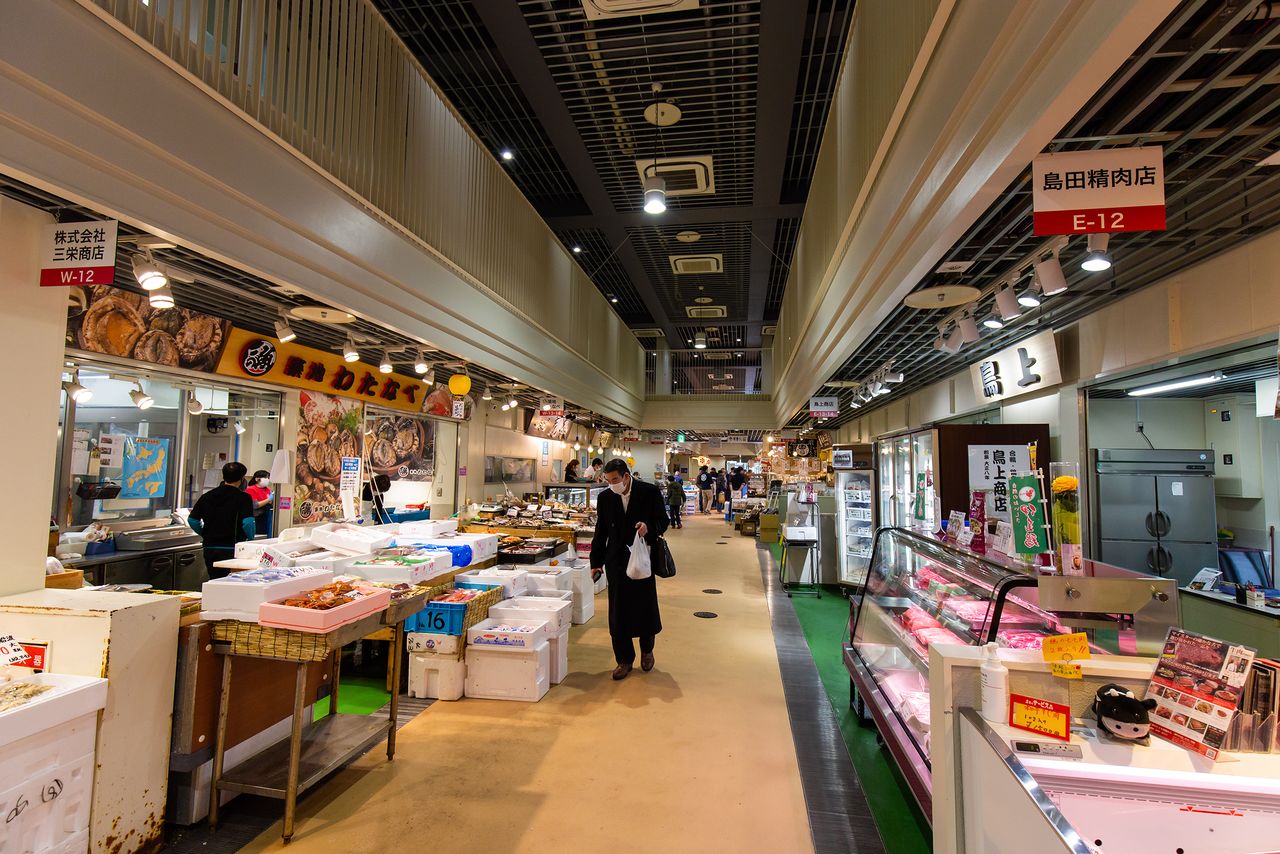
The shops offer a rich assortment of fresh seafood, meat, and fruits and vegetables.
When the wholesale market was located at Tsukiji, one of its major attractions was the ease with which nonprofessional shoppers could enter the central wholesale market section. This changed with the wholesale market’s move to the modern Toyosu facilities, where the public has only limited access. Security at Toyosu is even tighter now with the COVID-19 pandemic. At Tsukiji Uogashi, however, consumers can purchase high-quality fresh fish and shellfish carefully selected by the Toyosu wholesalers. Such a plentiful assortment is available, in fact, that some professional cooks who find the Toyosu wholesale market too inconvenient do their shopping here.
The first thing you are likely to see upon entering the Odawarabashi Building on Harumi avenue is a tuna carving demonstration. The demonstration is a daily event put on by Kitani Suisan, an intermediary wholesaler at Toyosu. Only high-quality tuna is selected for the show and the cuts are sold on the spot. Many of the pieces are cut to fill orders from sushi shops and other eateries, but there are always enough cuts and choice nakaochi remnants scraped from the skin and bones of the tuna for the general public. The most popular purchases are chunks of bluefin tuna from Ōma in Aomori Prefecture. Starting at ¥1,000 for a single 100-gram serving of three to four chunks, an average of 30 to 40 kilograms of bluefin tuna are sold every day. On some days 300-gram containers of the tuna chunks are sold at bargain prices under ¥2,000.
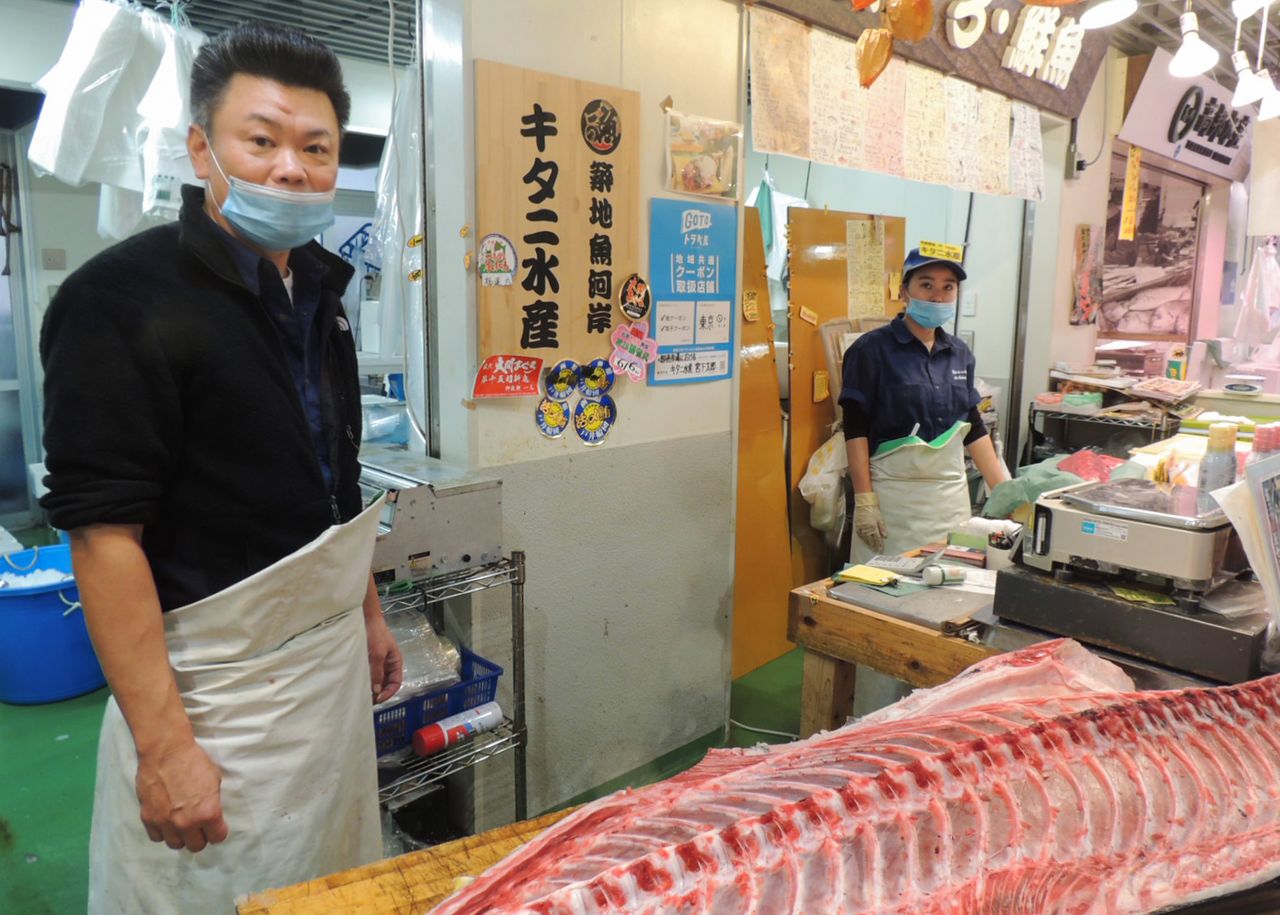
At Tsukiji Uogashi, Kitani Suisan sells bluefin tuna brought in directly from the Toyosu Wholesale Market. (Photo by the author)
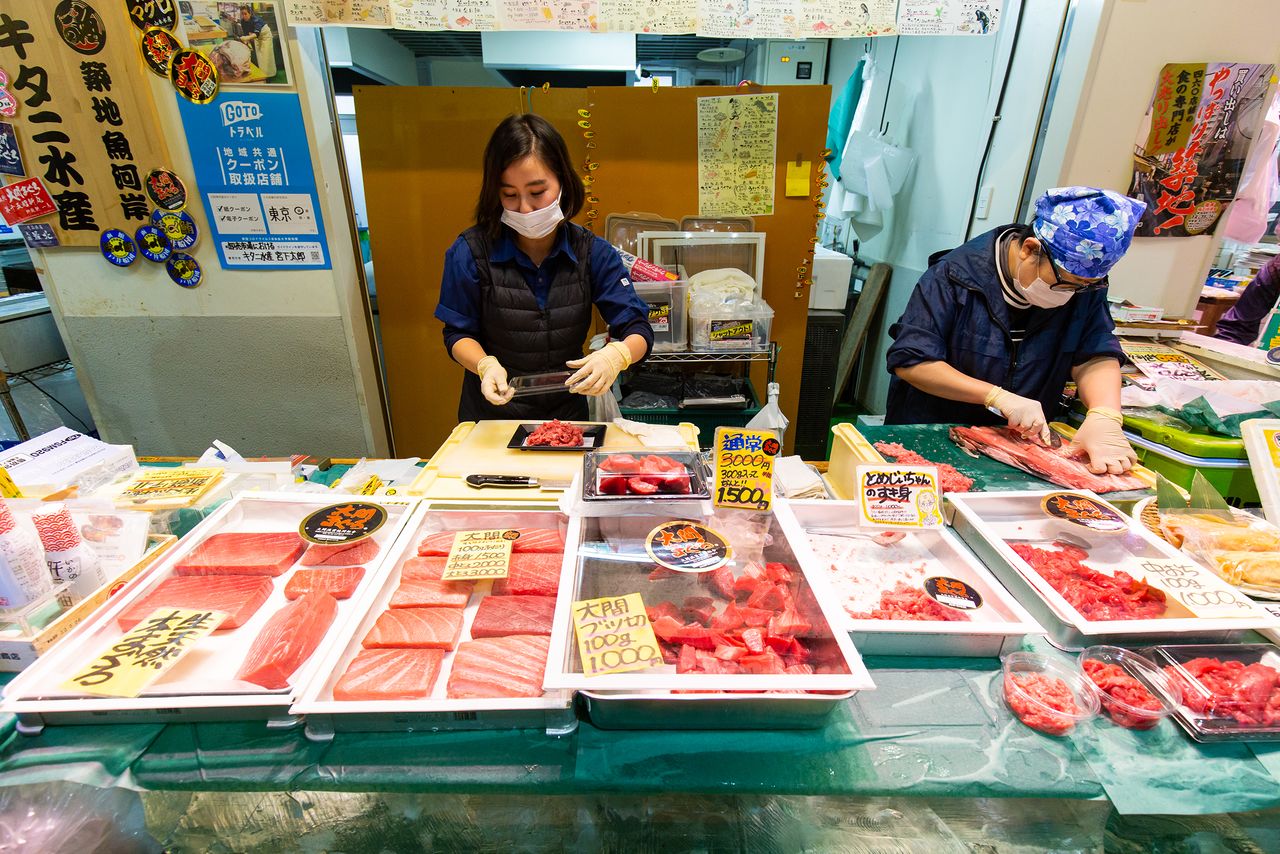
Choice cuts of Ōma blue fin tuna and nakaochi scrapings are on sale at reasonable prices.
Fresh Fish and Delicious Eateries
Well into the shopping area along Namiyoke-dōri you will come to Tsukiji Sankyō, a world-renowned vendor specializing in dashi soup stocks. A major supplier to famous restaurants, Tsukiji Sankyō offers an amazing variety of high-quality traditional Japanese stocks. The selection of fish stock is especially diverse, including bonito, freight tuna, and mackerel flakes as well as whole dried sardines.
Tsukiji Sankyō president Shimizu Yoshihiro recommends his firm’s high-grade Ibuki iriko dried sardines. “With the pandemic, more people are eating at home and are showing keen interest in how to make their own professional-quality soups.”
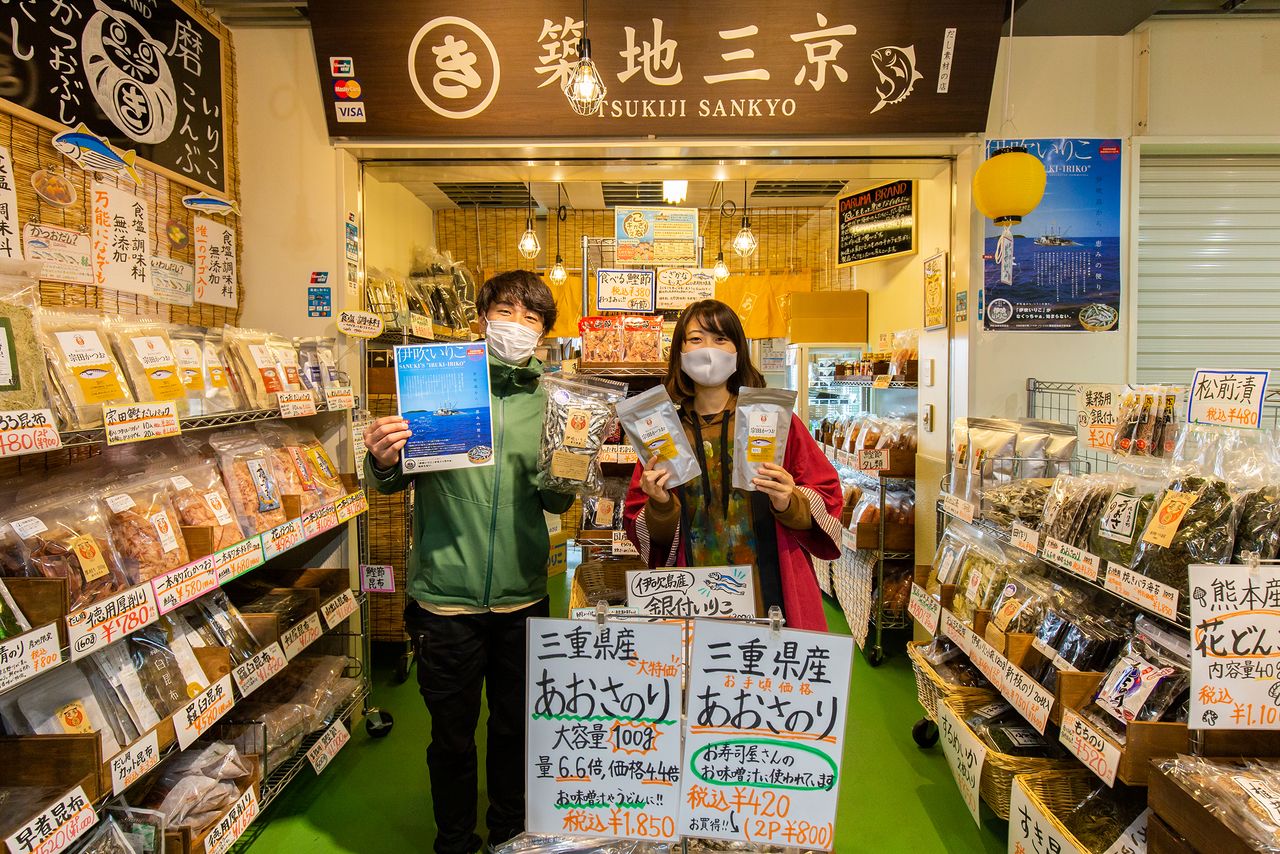
Store attendants display their popular offerings of Ibuki iriko (dried sardines) and Sōda katsuo (auxis or frigate tuna) fish stock flakes.
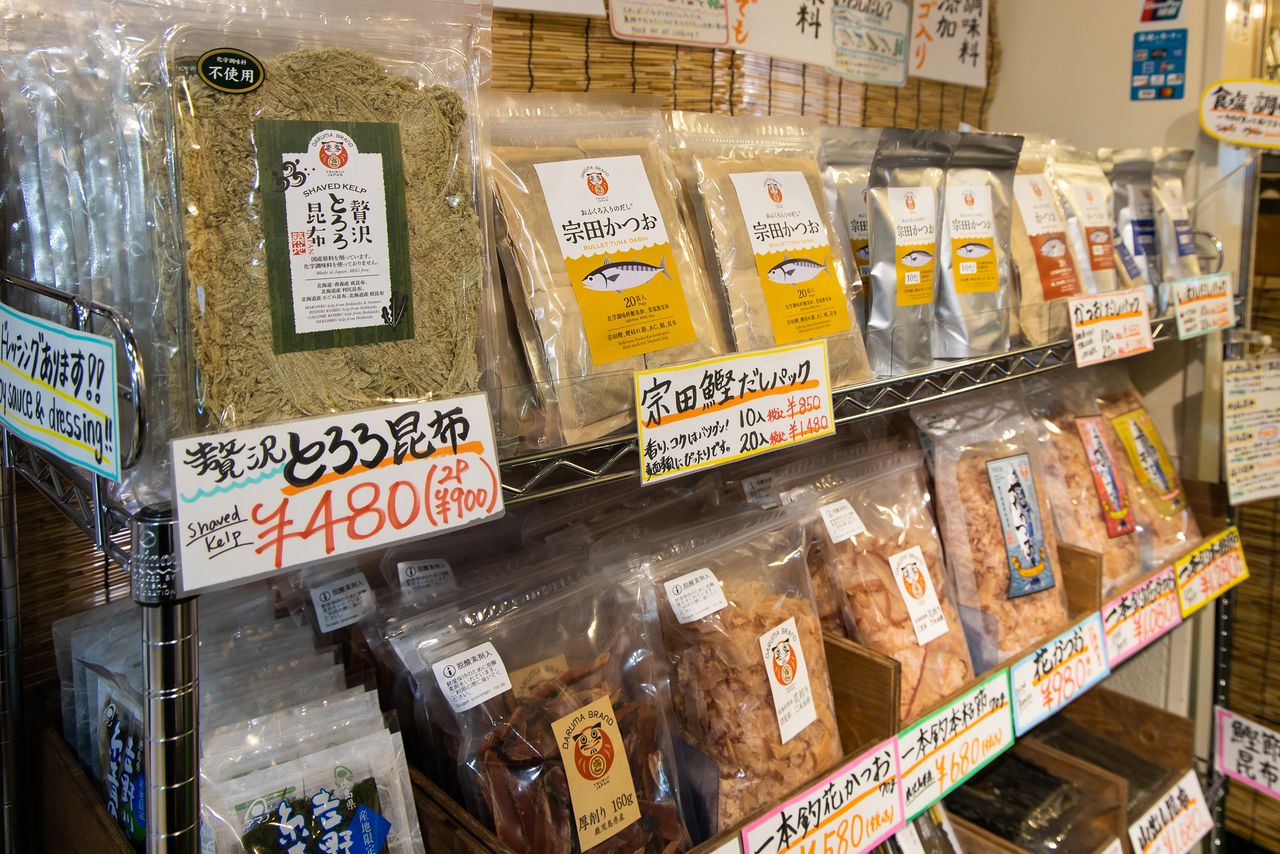
An array of fish flakes, dried kelp, and laver from well-known localities throughout Japan.
Other shops sell processed sea products, including dried fish and shellfish, nerimono boiled fish-paste products, and fresh seasonal vegetables including matsutake mushrooms. On the third floor of the Odawarabashi Building is the Uogashi Shokudō, a food court offering ichiba meshi dishes made from the market’s seafood, meat, and produce.
Even as the site of the former Tsukiji Wholesale Market remains empty due to the postponement of the Tokyo Olympics, it is clear this has not hindered the cooperative efforts of the Toyosu wholesalers and Tsukiji Outer Market retailers.
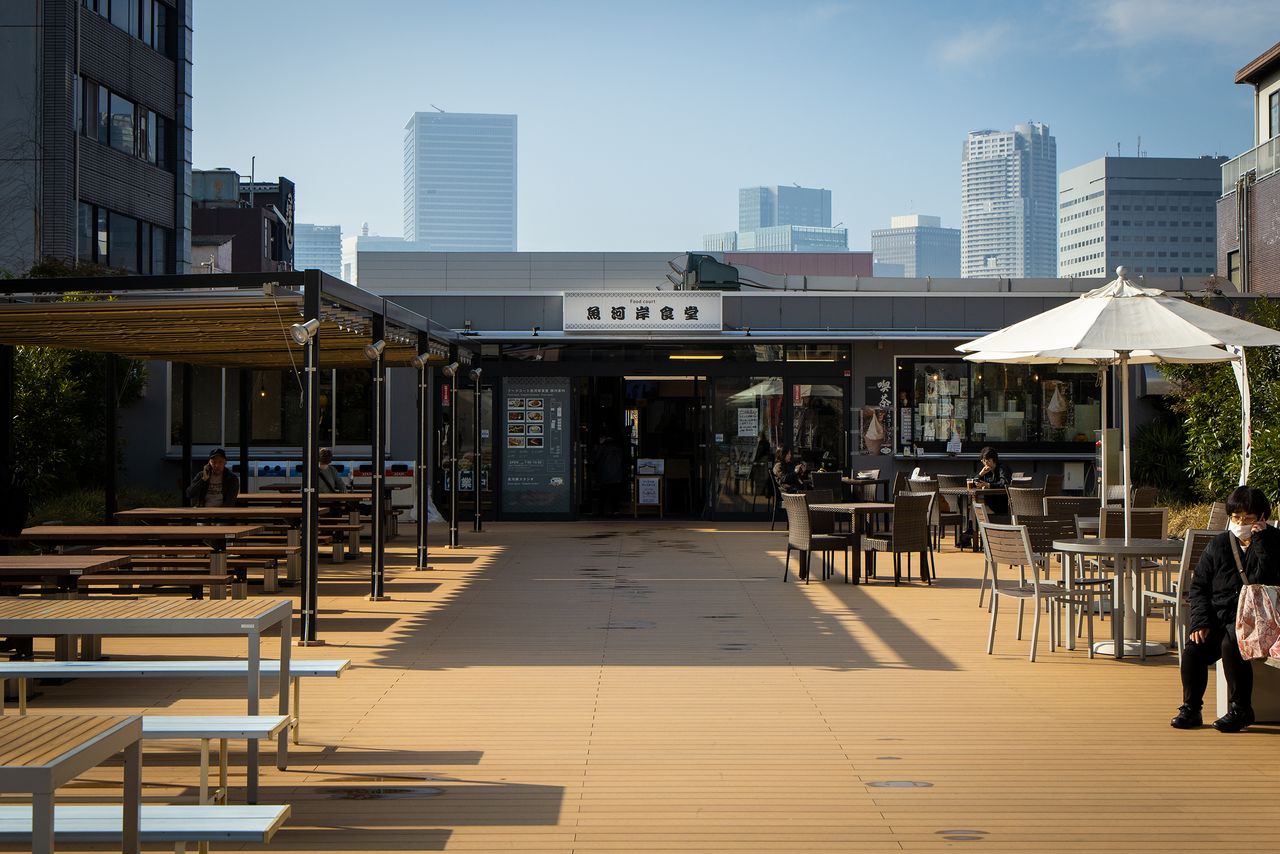
Outdoor seating is available at the Uogashi Shokudō food court on the third floor of the Odawarabashi Building.
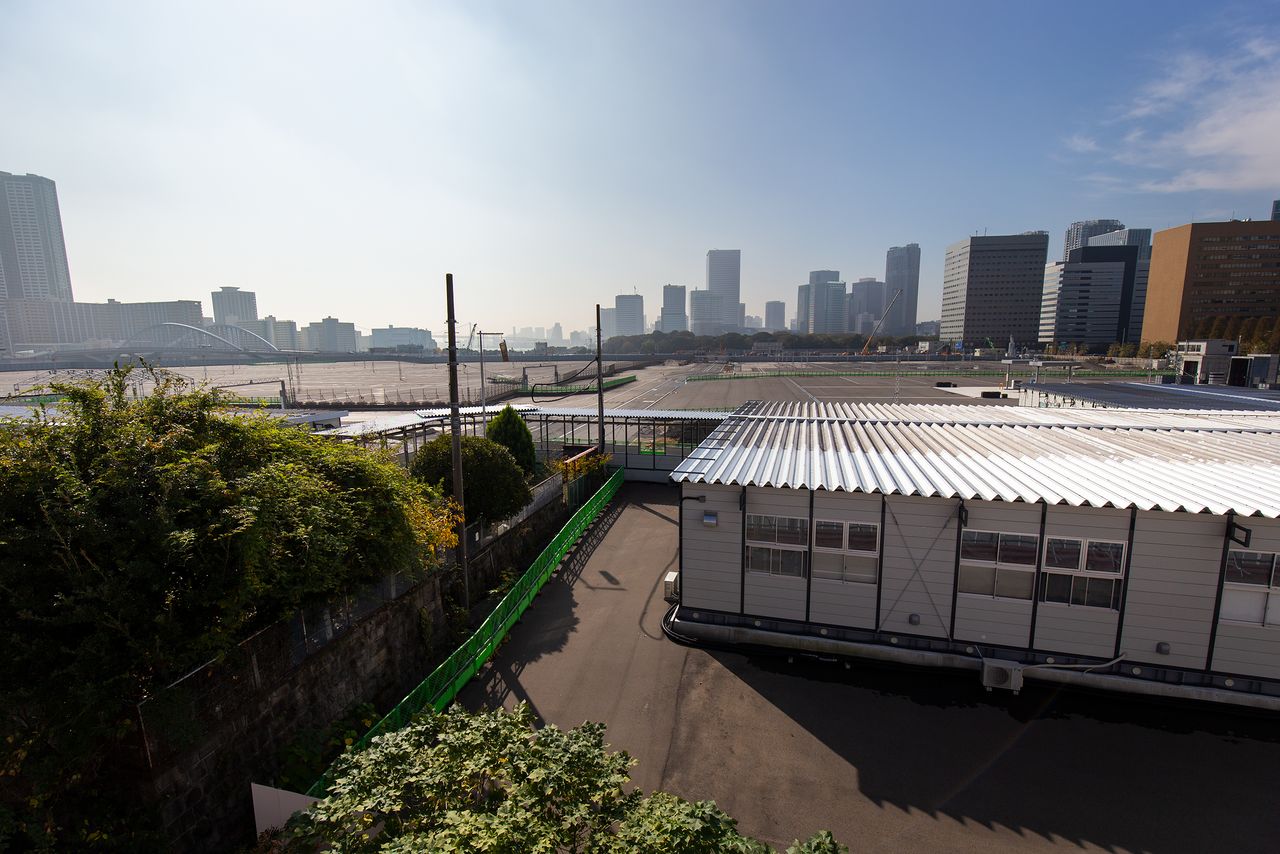
The former Tsukiji Wholesale Market site viewed from the roof of the Kaikōbashi Building.
Tsukiji Uogashi
- Address: Odawarabashi Building: 6-26-1 Tsukiji, Chūō-ku, Tokyo. Kaikōbashi Building: 6-27-1 Tsukiji
- Hours: 5:00 am to 3:00 pm. Closed to the general public until 9:00 am.
- Closed: Sundays, national holidays, and on some Wednesdays. In principle, closed on the same days as the Tokyo Central Wholesale Market
- Uogashi Shokudō food court: Open from 9:00 am. Hours differ by vendor.
Start Your Visit at Plat Tsukiji
Shops line the main roads and alleyways of the Tsukiji Outer Market. When you don’t know where to go to find what you are looking for, or whenever you have questions, you should stop by Plat Tsukiji, the area’s information center. The NPO facility is managed by Yamazaki Yoshiko, who says, “We don’t have the busloads of overseas visitors from China and elsewhere that used to come here. Still, we’re seeing a slow but steady increase in customers from local businesses and residents.”
The information center has coin lockers for storing large pieces of luggage and shopping items while you take a break for a meal, and during regular business hours you can deposit larger luggage and baby strollers for a fee. If you buy too much to carry home, there are delivery services conveniently located nearby. A giftshop inside the facility sells T-shirts with the characters for Tsukiji, 3-D postcards of nostalgic scenes from the old Tsukiji market, Hello Kitty shopping bags, and other unique gift items.
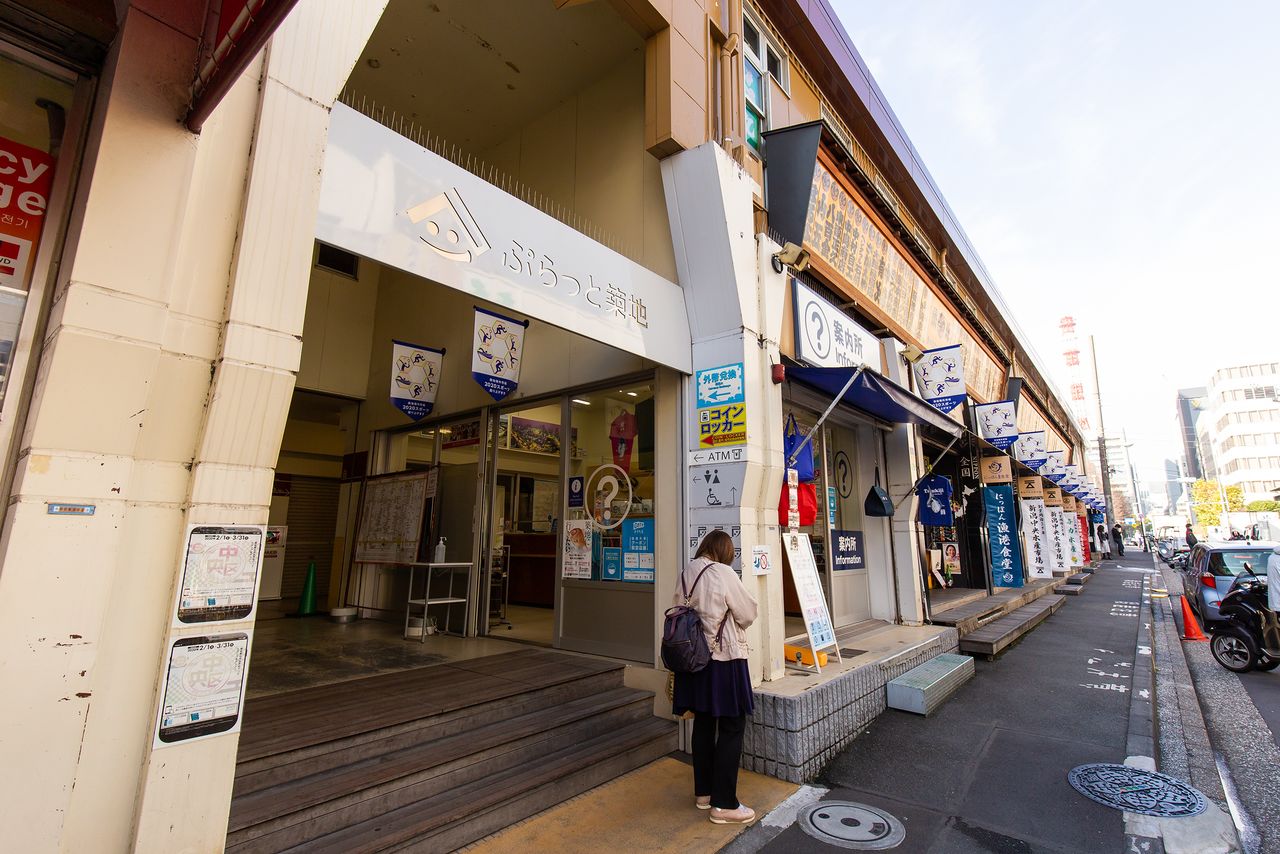
Plat Tsukiji is located roughly midway along Namiyoke-dōri. The facility also has rest areas and smoking booths.
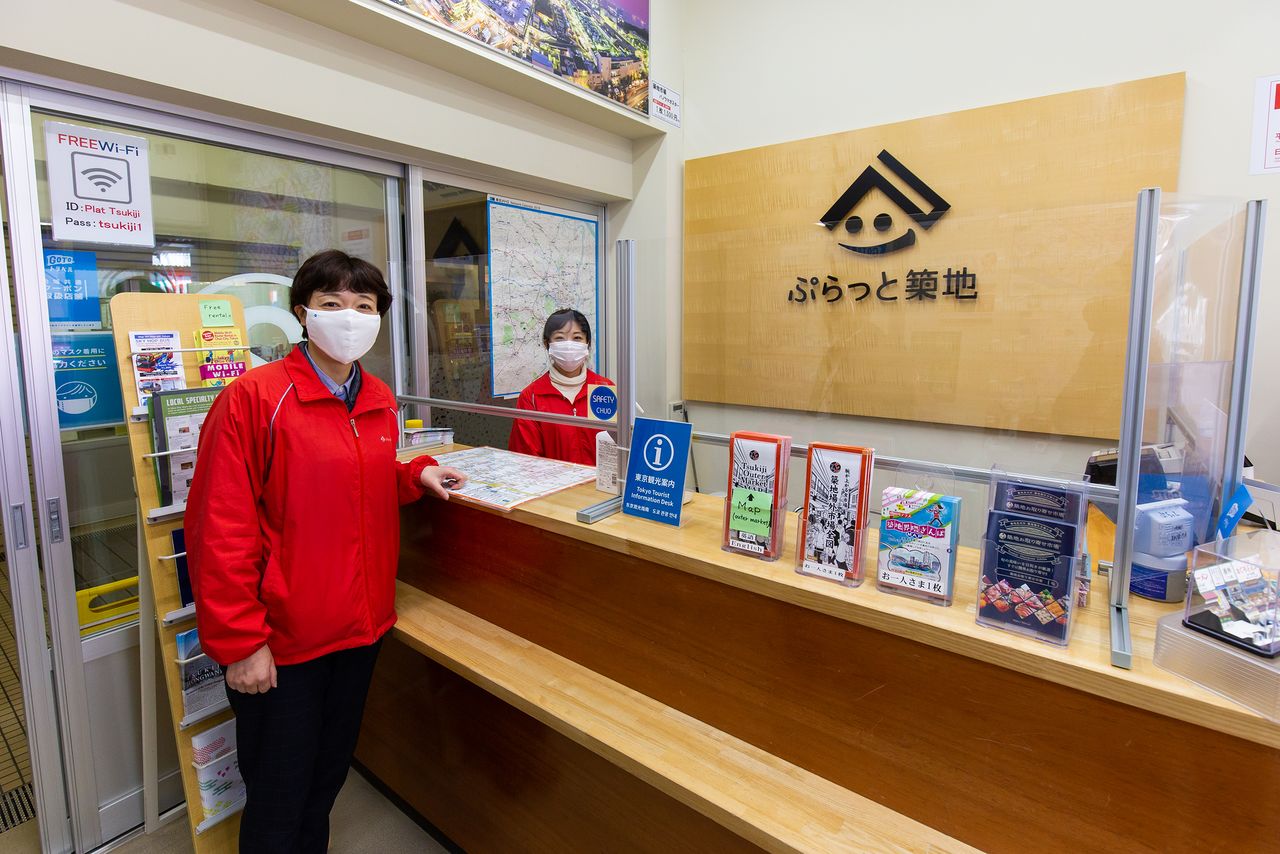
The Tsukiji Outer Market is a bewildering maze of shops. Make sure to pick up a map at the information booth. Yamazaki Yoshiko, the booth’s manager, is at left.
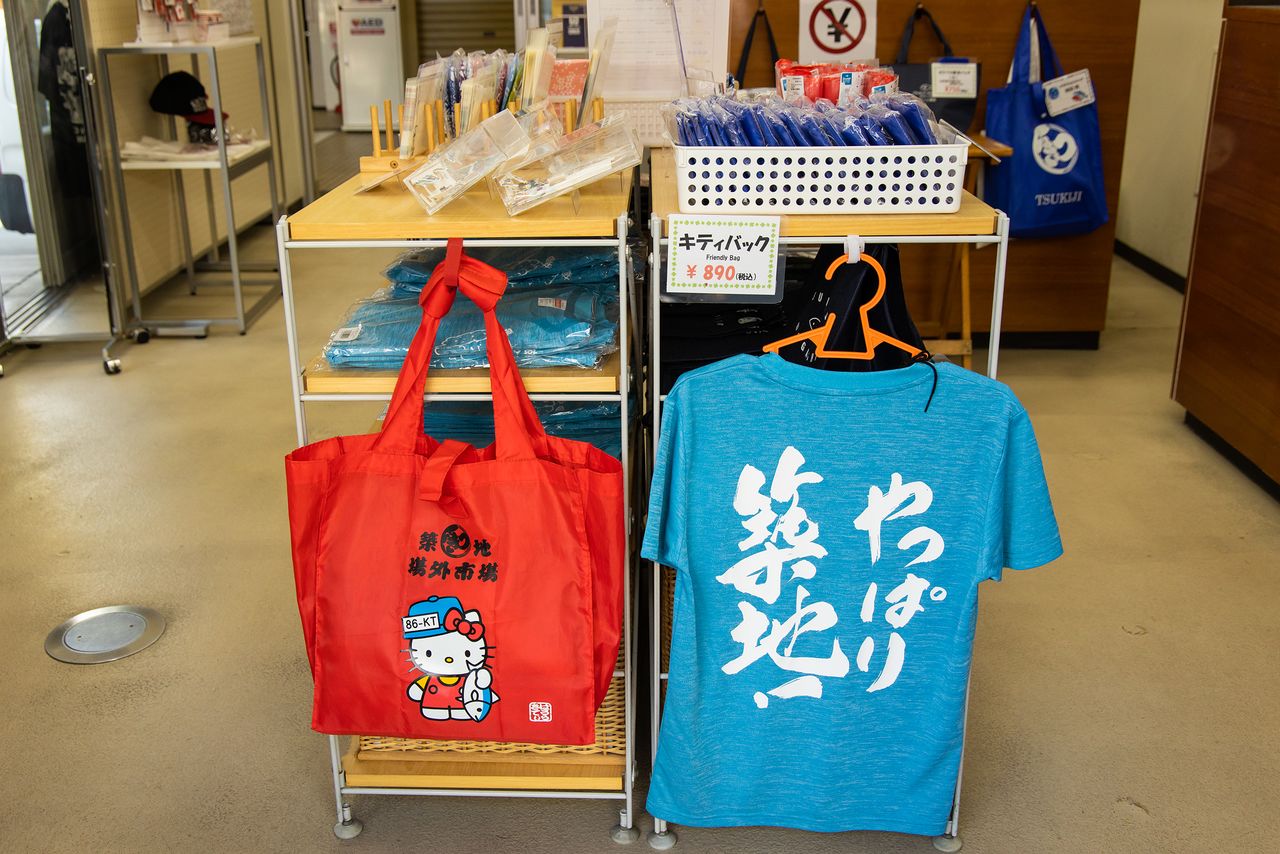
Some of the original items sold in the gift shop.
Plat Tsukiji Information Center
- Address: 4-16-2 Tsukiji, Chūō-ku, Tokyo
- Hours: 8:00 am to 2:00 pm on weekdays and Saturdays. 10:00 am to 2:00 pm on Sundays, national holidays, and days that the central wholesale market is closed.
- Closed: Year-end/New Year holidays
- Website: https://www.tsukiji.or.jp/english/plattsukiji/
Novel Snacks and Delicious Sweets
I could go on forever about the many great sushi shops and seafood bowl vendors, but will limit myself here to brief introductions to unique and relatively new offerings in the area.
Tsukiji Yamachō, right in front of Plat Tsukiji, is a specialty tamagoyaki Japanese-style omelet shop that was the first in the Tsukiji area to sell small pieces of tamagoyaki on skewers, at just ¥100 per stick. Called kushidama, this delicious snack is made with prime ingredients and comes in a variety of flavors including sweet and not-so-sweet, and fillings including crab, prawn, scallop, scallions, and pepper. With so many choices it is hard to pick just one, but the most popular is the Edomae type served at sushi shops.
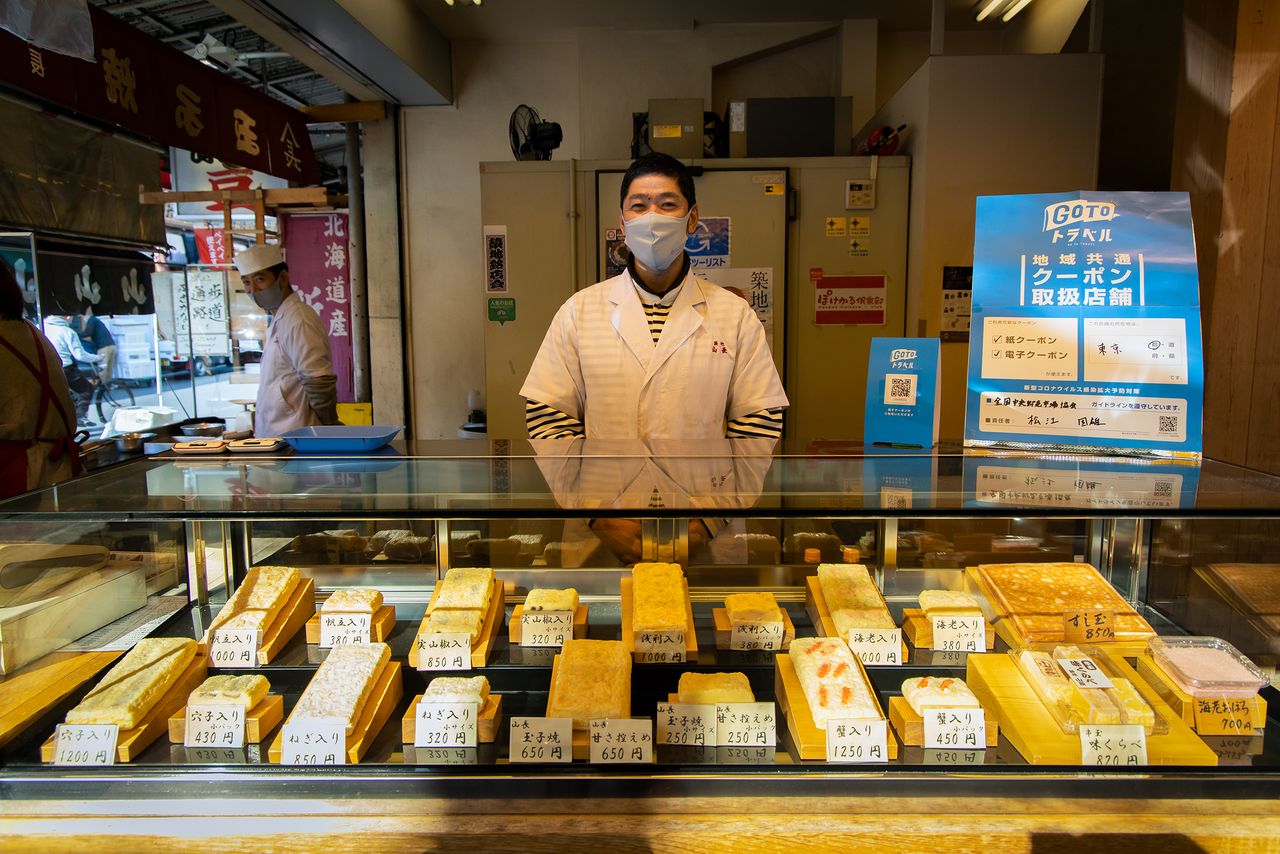
A mouthwatering variety of tamagoyaki. The Ajikurabe assortment of four different kinds of kushidama, priced at ¥820, makes a nice gift item.
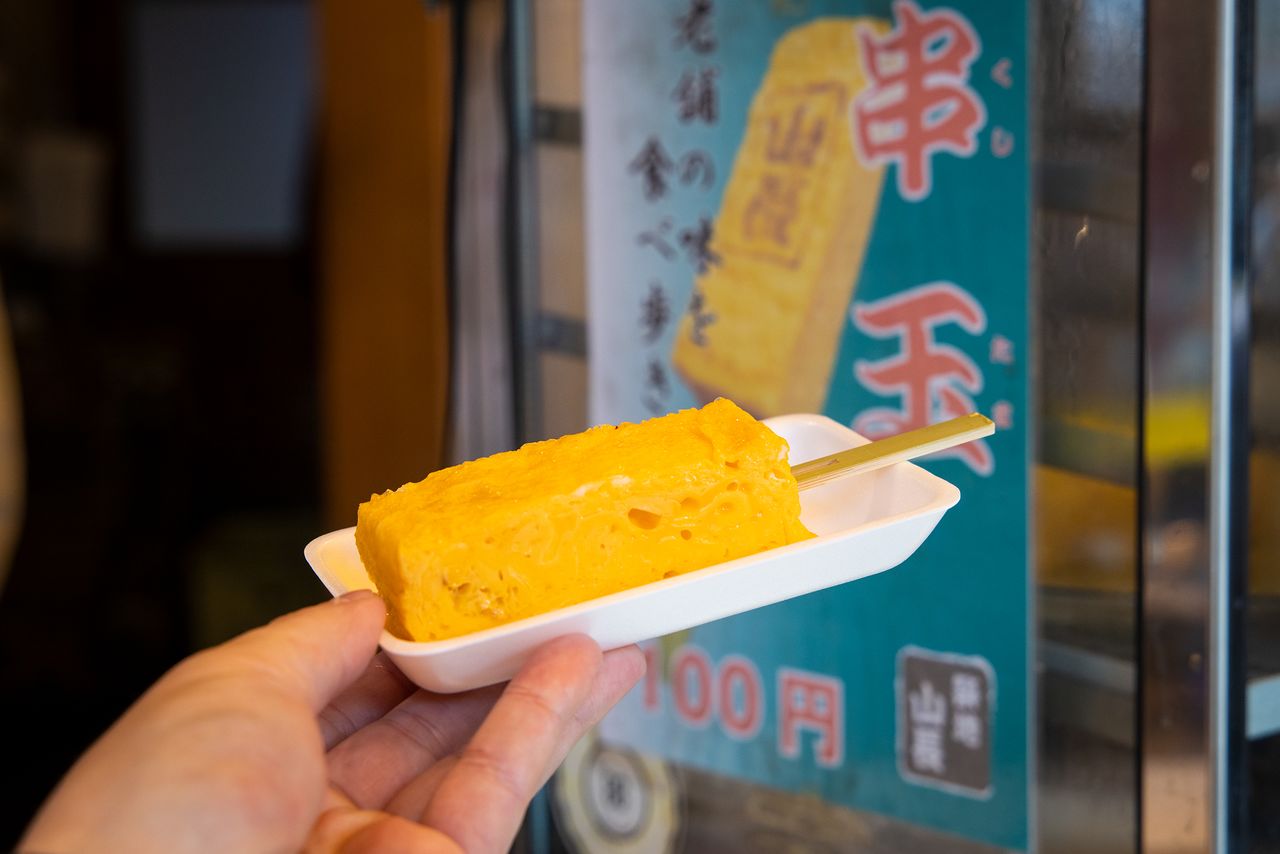
Kushidama omelet sticks are a great snack to munch on while you explore the Tsukiji Outer Market. Due to the COVID-19, eating while walking about is currently forbidden. Try out your favorite kushidama in front of the shop.
After you have enjoyed a hearty snack, go in search of Tsukiji’s rich offering of sweets. From Yamachō go down Shin Ōhashi avenue a little way and you’ll notice the sweet fragrance coming from La Créme au Beurre, a butter cream specialty shop. This shop uses only the best eggs and other ingredients to make its confections. The macaroons are especially popular, but you’re certain to enjoy the mille-feuille too.
Continue along Shin Ōhashi avenue until you get to Tsukijinishi-dōri and then turn towards Harumi avenue. On your right you will come to Tsukiji Sanokiya famous for its maguroyaki pancakes shaped like tuna rather than the sea bream shape of the usual taiyaki. Popular are the crisp honmaguro pancakes (¥220) filled with sweet bean paste. The chūtoro pancakes (¥240) are normally filled with sweet bean paste and apricot, but due to the poor apricot harvest this autumn, the apricot has been replaced by yuzu citron or pineapple. The Kihada maguro pancakes (¥240) filled with creamed custard are also popular.
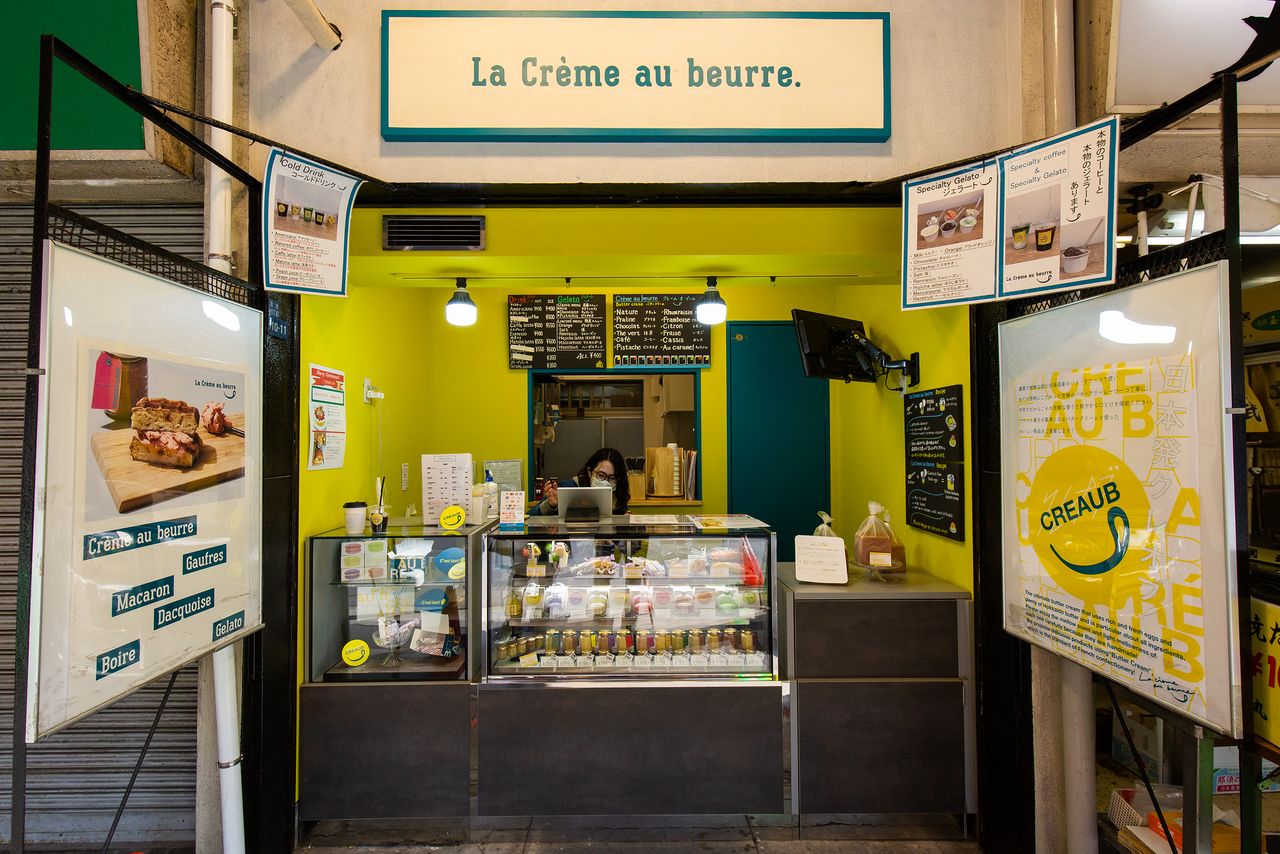
The quaint little La Créme au Beurre is an unexpected feature of the Tsukiji Outer Market.
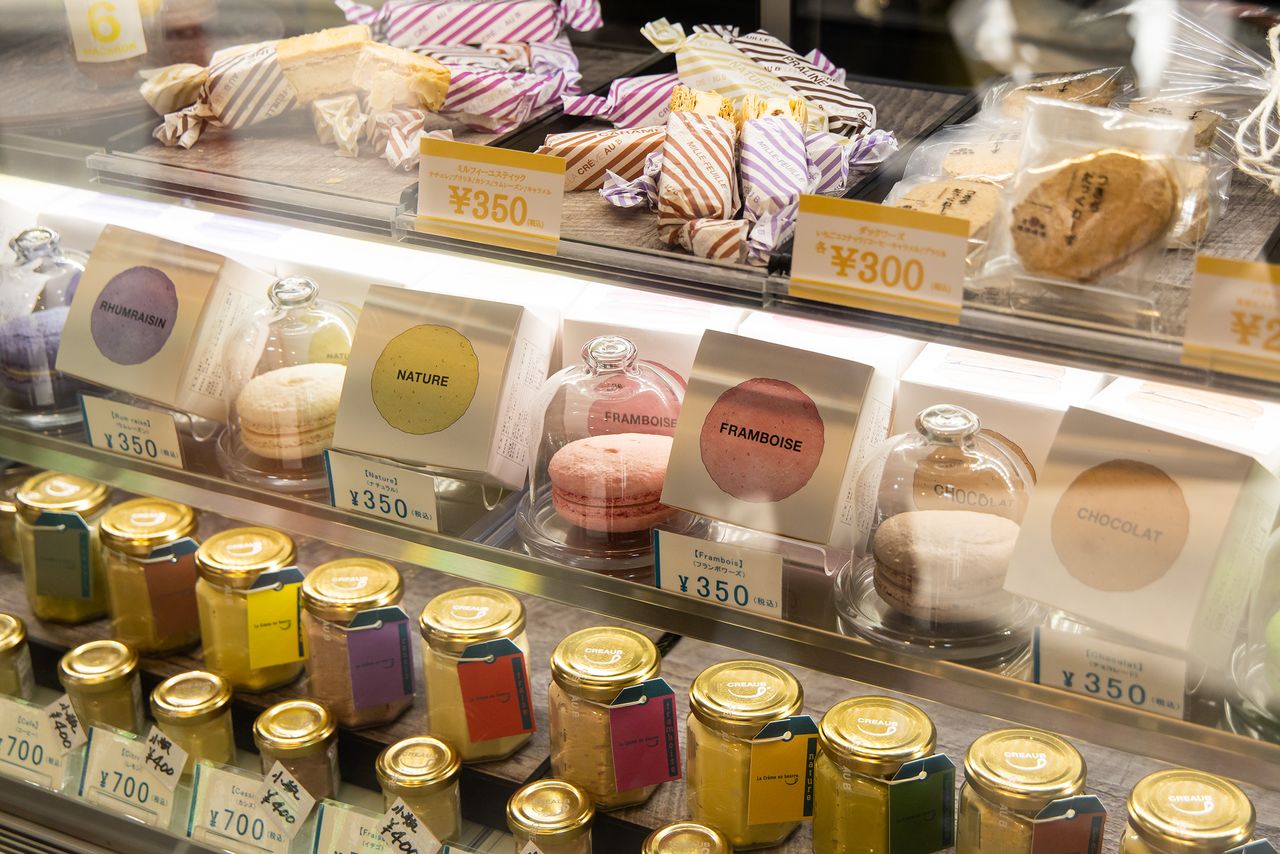
Macaroons of all colors make for a festive showcase.
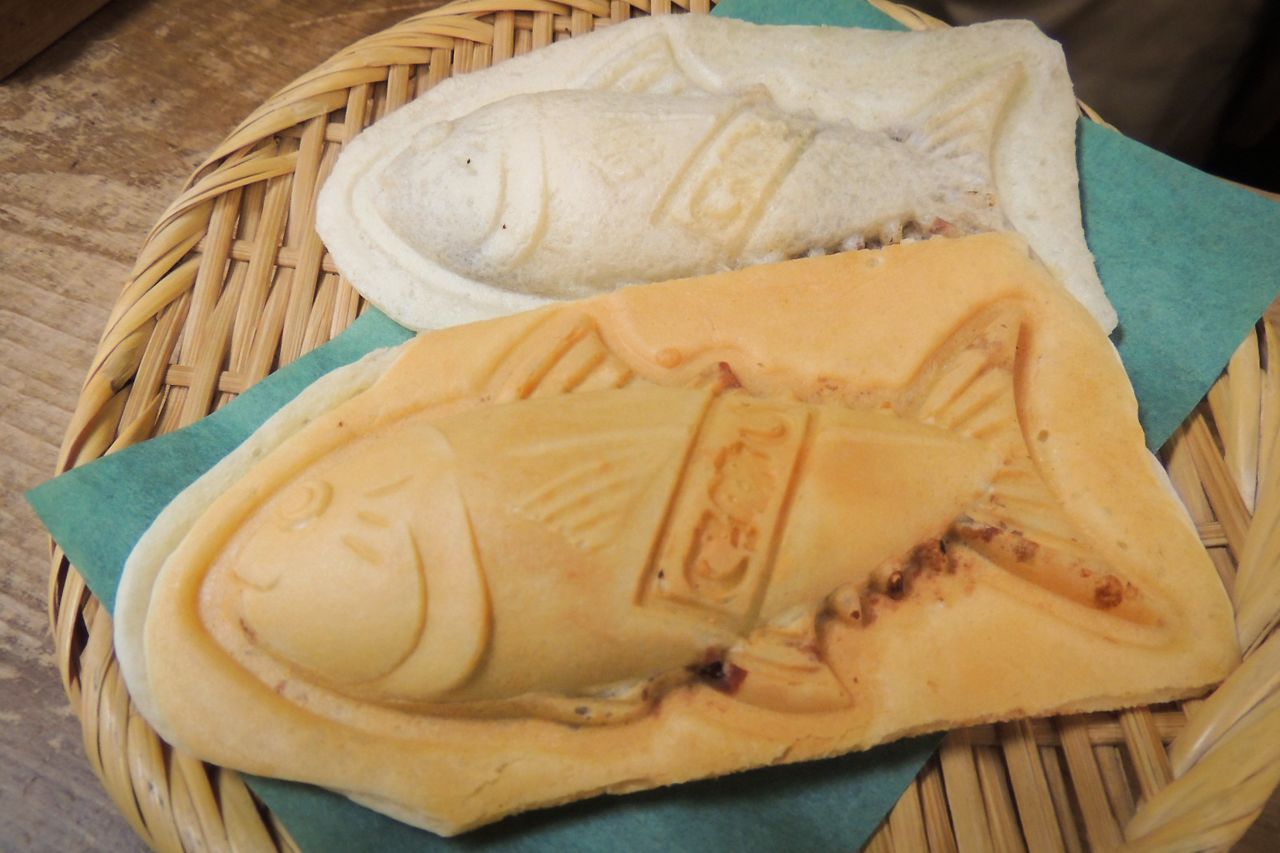
Tsukiji Sanokiya’s maguroyaki pancakes, with honmaguro in the foreground and chūtoro maguro in the back. (Photo by the author)
New Faces
The Tsukiji Outer Market is not just all about food. Also to be found here are the tools and other materials used by professional chefs. Nenohi, located on Namiyoke-dōri, specializes in knives. It just reopened in 2020 after undergoing extensive remodeling. The shop has an amazing assortment of traditional Japanese knives, including special blades for cutting soba noodles and peeling the skin off of blowfish. The premium-grade and special-order knives displayed in the far back of the shop are something to see. The large sword-like knives used in tuna carving demonstrations can cost as much as ¥2 million.
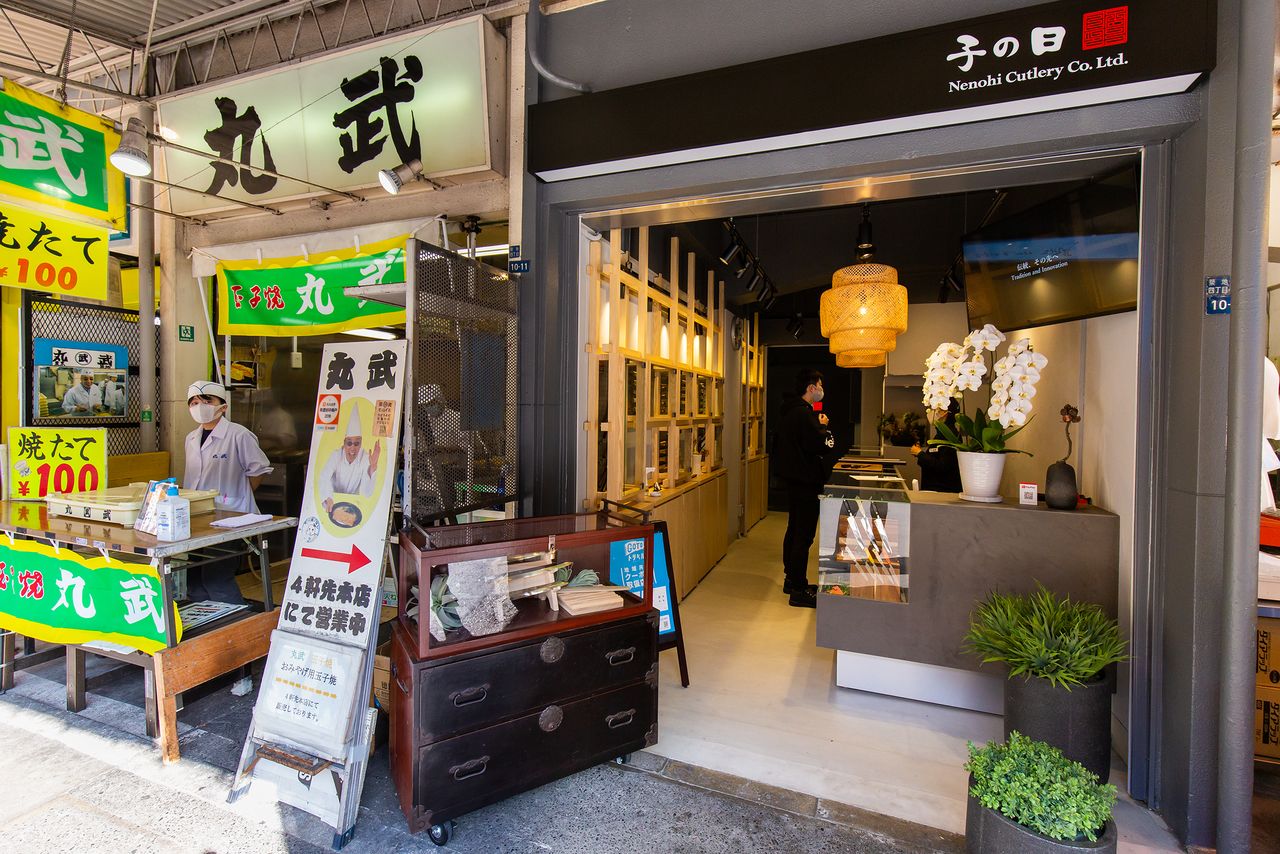
The front entrance of Nenohi adjacent to another famous tamagoyaki shop, Marutake.
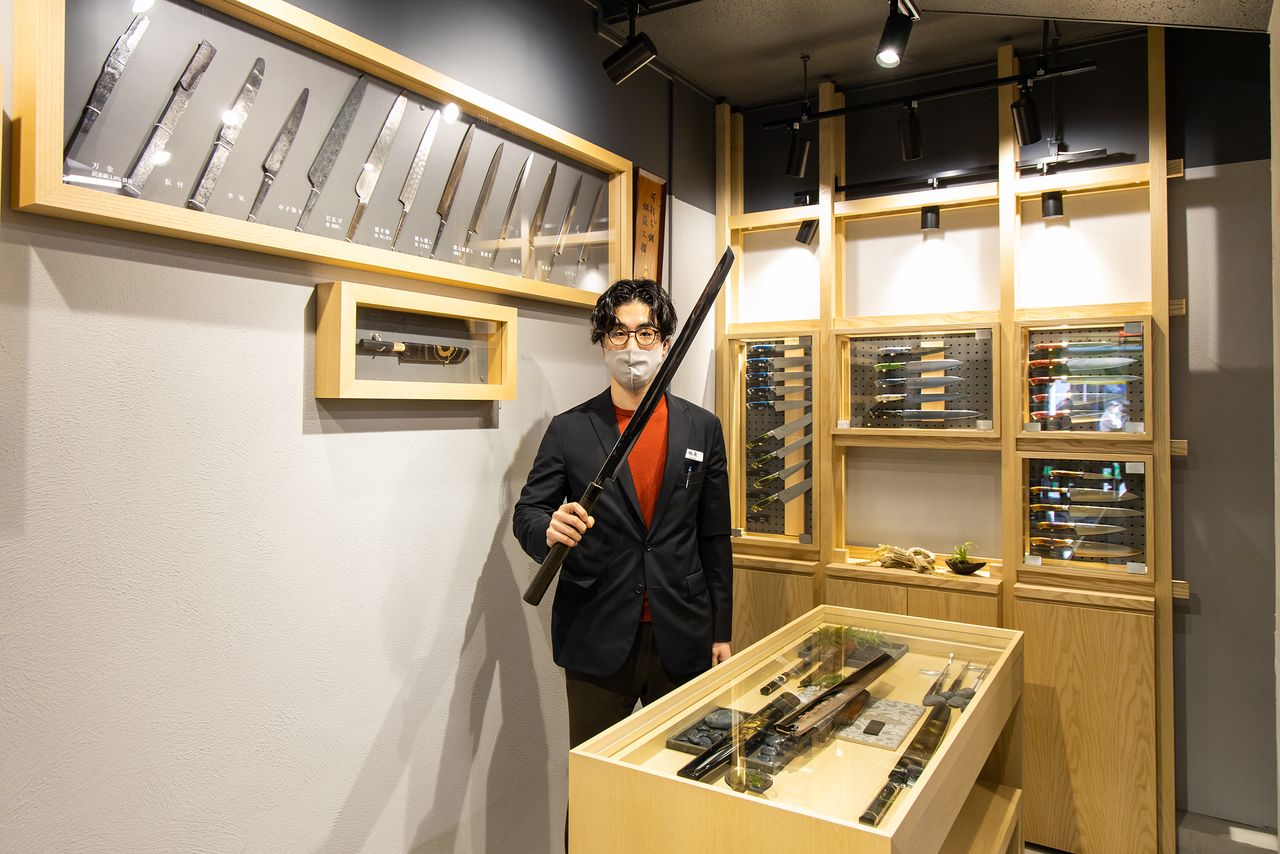
An attendant shows some of the sword-like knives kept in the far back of the shop.
In August 2017, just prior to the move of the wholesale market to Toyosu, a great fire swept through the shops along Monzeki-dōri. Despite concerns that the Tsukiji Outer Market would not survive the conflagration, a number of the shops have returned in new forms. On the site of the once-popular ramen shop Inoue, shoppers will now find Tonboya, which sells nothing but ¥500 tuna steaks out of an old-fashioned kitchen car. The delicious tuna tail ends, braised on a skewer, can be eaten on the spot or taken home for later enjoyment. The cuts appear to be rich in fat but are surprisingly flavorful and light to eat.
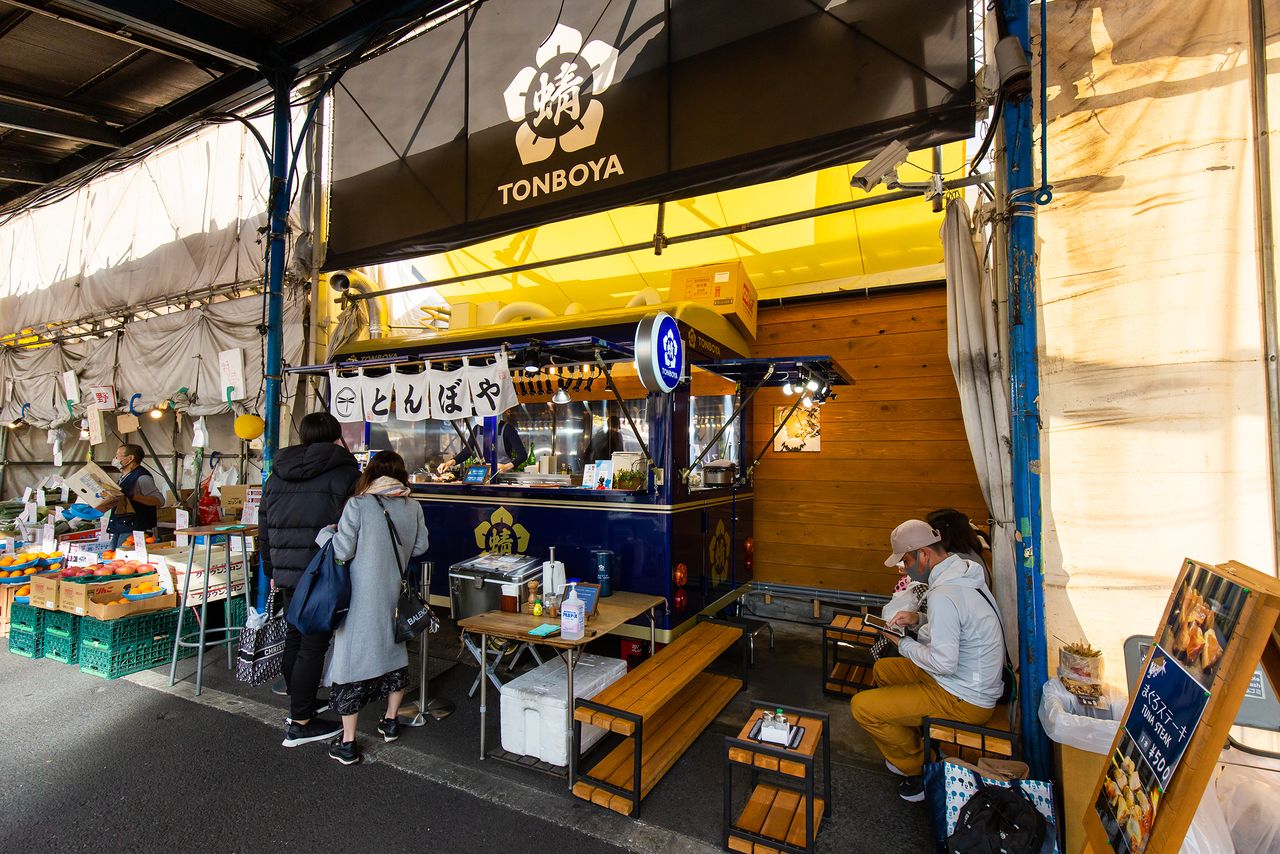
Tonboya is located on Monzeki-dōri at a site that was devastated by fire just a few years ago.
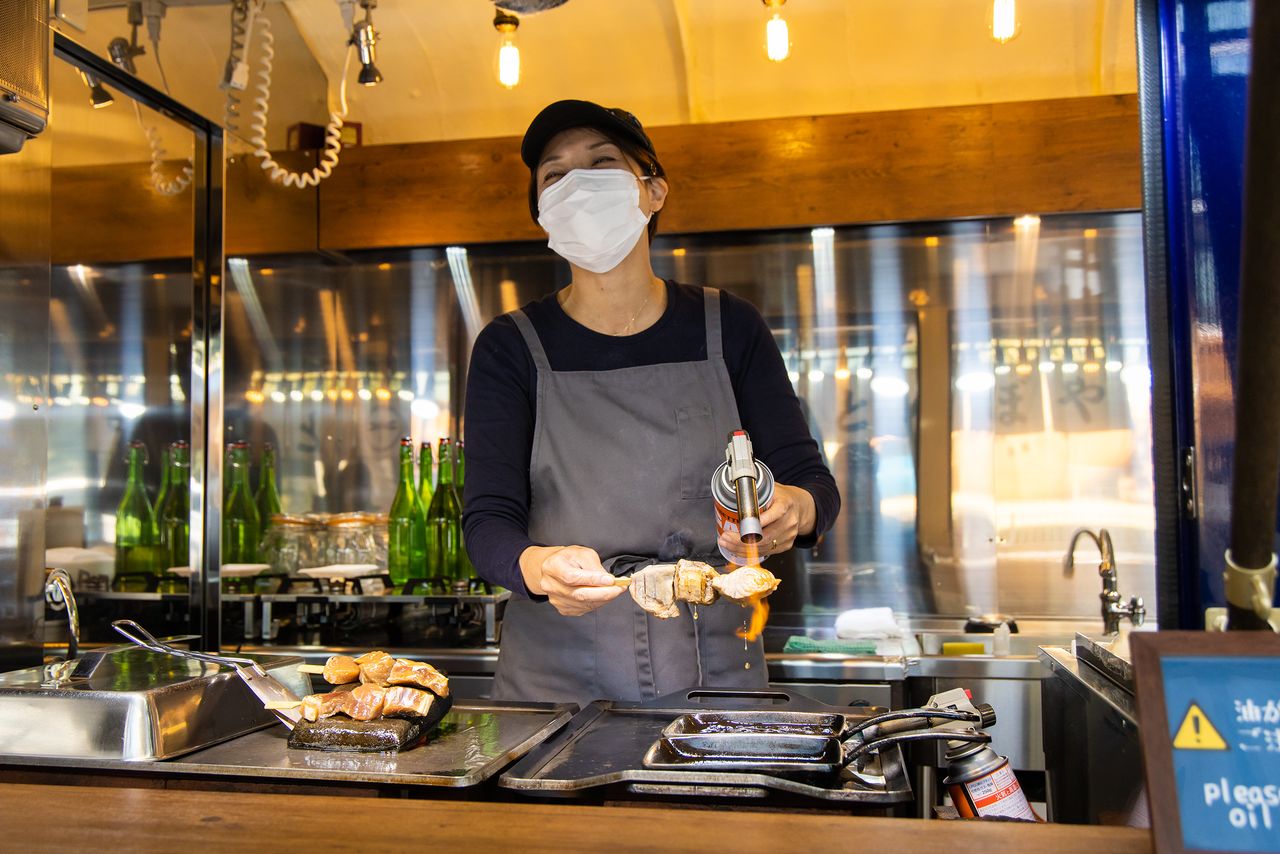
Fat drips off the skewered tuna steaks as they are braised with a gas torch.
The end of the year is an especially busy time for the shops of the Tsukiji Outer Market, but crowds can be expected at any time. Shikagawa Kengo, business manager of the Tsukiji Food Town Council urges visitors and shoppers to “avoid the three Cs—closed spaces, crowding, and close proximity—wear a mask, and abide by the rule of no walking while eating.”
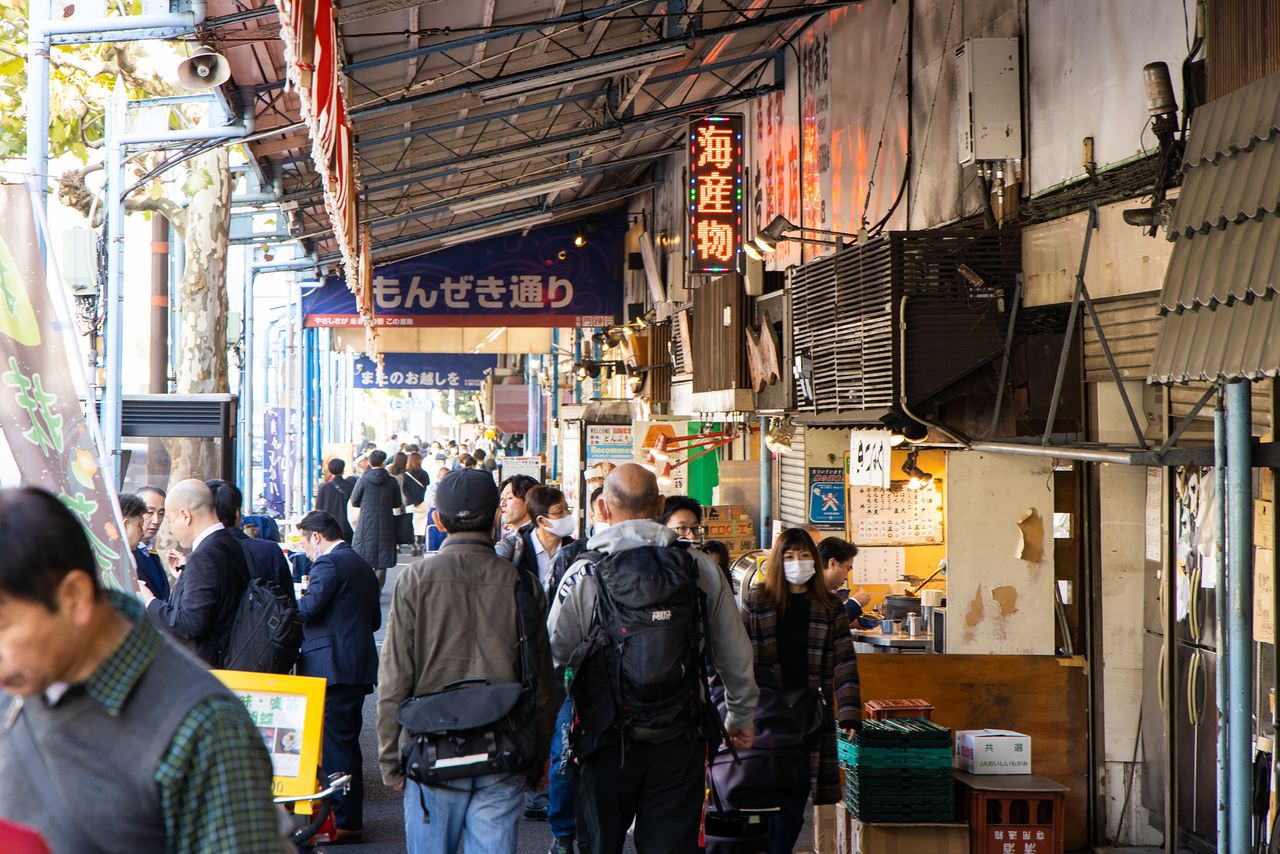
People flock to Monzeki-dōri even on weekdays.
(Originally published in Japanese. Photos © Nippon.com except where otherwise noted. Banner photo: A tuna carving demonstration put on by Kitani Suisan staff on Namiyoke-dōri.)